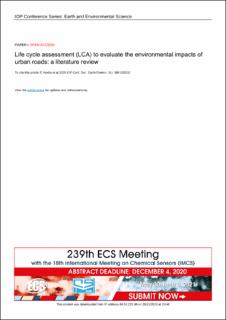| dc.contributor.author | Hoxa, Endrit | |
| dc.contributor.author | Vignisdottir, Hrefna Run | |
| dc.contributor.author | Passer, Alexander | |
| dc.contributor.author | Kreiner, Helmuth | |
| dc.contributor.author | Wu, Shaopeng | |
| dc.contributor.author | Li, Jiashuo | |
| dc.contributor.author | Bohne, Rolf André | |
| dc.date.accessioned | 2021-01-25T14:20:54Z | |
| dc.date.available | 2021-01-25T14:20:54Z | |
| dc.date.created | 2020-11-22T20:25:45Z | |
| dc.date.issued | 2020 | |
| dc.identifier.issn | 1755-1307 | |
| dc.identifier.uri | https://hdl.handle.net/11250/2724606 | |
| dc.description.abstract | With the ratification of the Paris climate agreement to avoid the uncompensated effects of climate change, 197 countries will have to dramatically reduce their greenhouse gas emissions in half by 2030. In the case of the urban space, roads are responsible for the consumption of 105M tons of bitumen and 115M tons of the world's greenhouse gas emissions. For this reason, the reduction of the environmental impacts of road construction is becoming an urgent necessity. So far the vast majority of the Life cycle assessment (LCA) has been used to evaluate the environmental burdens of existing roads and new asphalt solutions. However, due to the different LCA methodological choices, recent studies have highlighted the difficulties in comparing the results of cases published in literature. Driven by this knowledge gap, the aim of the present study was to identify key aspects missing in the assessment of urban roads. Through a Systematic Literature Review (SLR), 47 publications have been selected for further investigation. An intensive analysis of these documents clearly demonstrate the heterogeneity of the applied LCA methodological choices as well as the selected approaches regarding i.e. the goal of the studies, functional unit, system boundary, database and stratigraphy of the road pavement. Aiming to harmonize the LCA methodology, we have identified key aspects that require solutions for a robust LCA application. The results are expected to be useful for the National Road Administration (NRA) in assessing the environmental impacts of future urban road projects. As a response to the Paris climate agreement targets, the application of harmonized methods regarding LCA should lead to a more robust and structured process in terms of identifying low carbon urban road solutions and contributing to the SDGs respectively. | en_US |
| dc.language.iso | eng | en_US |
| dc.publisher | IOP Publishing | en_US |
| dc.rights | Navngivelse 4.0 Internasjonal | * |
| dc.rights.uri | http://creativecommons.org/licenses/by/4.0/deed.no | * |
| dc.title | Life cycle assessment (LCA) to evaluate the environmental impacts of urban roads: a literature review | en_US |
| dc.type | Peer reviewed | en_US |
| dc.type | Journal article | en_US |
| dc.description.version | publishedVersion | en_US |
| dc.source.volume | 588 | en_US |
| dc.source.journal | IOP Conference Series: Earth and Environmental Science (EES) | en_US |
| dc.source.issue | 032032 | en_US |
| dc.identifier.doi | 10.1088/1755-1315/588/3/032032 | |
| dc.identifier.cristin | 1850787 | |
| dc.description.localcode | Content from this work may be used under the terms of the Creative Commons Attribution 3.0 licence. Any further distribution of this work must maintain attribution to the author(s) and the title of the work, journal citation and DOI. | en_US |
| cristin.ispublished | true | |
| cristin.fulltext | original | |
| cristin.qualitycode | 1 | |

